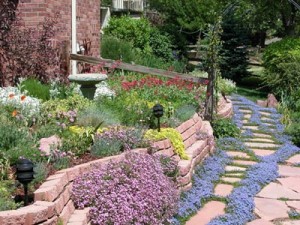
So Mary, how does it grow? With wisely planted trees and shrubs, and many sunny days without rain in a row. It’s called water-wise gardening my friends.
Did you know an average Bay Area home uses almost 80% of its total potable water for simply watering the lawn and plants? What would you say if you found out you can have a glorious looking landscape by spilling a drop instead of a bucket to water it? Just imagine the water savings and your water bill at the end of the month. In fact, read on and I’ll tell you where you can get a $1000 rebate for going water-wise!
Don’t be afraid, “sustainable” landscaping doesn’t mean rocks and once a year blooming cactus. By understanding our climate zone, soil type, sun and shade conditions, and the water requirements of your site, you can have lush and beautiful garden if you practice some fundamental principles of water conservation.
Why Landscape to Conserve Water?
Drought is a part of the natural weather cycle of the West. Even though we have been able to import water from other areas, our population is rapidly outgrowing existing water supplies. In the years ahead, water conservation and water-wise landscaping will need to become a part of every westerner’s lifestyle.
Use water conserving plants: The key is to choose plants that are naturally adapted to our region’s condition. I’ve listed several of my favorite trees and shrubs below:
Trees : Bristlecone fir, sweet acacia, California buckeye, madrone, incense ceder, palo verde, Various species of cypress pine and oak, and giant sequoia.
Shrubs: Cape mallow, manzanita, wild lilac, toyon, lavender, cape plumbago, and rosemary.
Trees and shrubs are the “bones” of your garden. You can create dynamic changes by adding lots of perennials and bulbs in your planting beds and ornamental grasses to add texture and movement.
Group Plants Wisely
For efficient irrigation, group water thirsty plants and drought- resistant plants separately. Consider planting azaleas, Japanese maples, ferns, rhododendron, and hydrangeas together to create a heavier irrigation zone. In another area, you might plant California natives, such as Toyon and California lilac, and drought tolerant plants, such as Cape Mallow, to create a lighter irrigation zone.
Limit Turf Area
A lawn requires more irrigation than almost any other landscape element. Limit its size to what you really need for outdoor recreation. Choose a grass that is adapted to our climate. For our Sunset climate zone 16, tall fescues, dwarf tall fescue ‘Bonsai’ ‘ Twilight’, and Buffalo grass work best.
Consider replacing at least part of your lawn with a deck or patio. Groundcovers, including mondo grass, dymondia, gazania, and wooly thyme, make wonderful alternative lawns.
Irrigate efficiently:
Make sure your watering practices and devices are as efficient as possible.
- Water plants only when needed.
- Water at night when evaporation is much lower and air is calmer.
- Tighten faucets, repair leaks, and clean filters. Check nozzle spray to avoid runoff and overspray.
Improve your soil’s water retention by regularly adding organic matter, such as compost. For compacted soil, you can improve air and water penetration by aerating the soil with a heavy duty drill. Bore holes that are 18” to 26” deep 4 to 5 feet apart within the drip line of the tree.
Use Mulch:
Apply a layer of mulch around plants. Organic mulches, such as shredded bark, compost, aged sawdust, old cardboard, shredded paper, are the best because they add organic matter to the soil as they break down. Mulch reduces weeds, slows erosion, and reduces moisture loss through evaporation.
Control weeds:
Weeds are garden intruders that rob water from desirable plants. Pull weeds before they go into their flowering stage. Using chemicals to kill weeds is not a good practice because they disturb soil pH and kill beneficial microbes in the soil.
Water Rebate Program:
By becoming a water-wise gardener you could save hundreds of dollars a year on your irrigation bill and protect our state’s precious water supply. A nice bonus is the Santa Clara Valley Water District has two rebate programs to help you turn your landscape into a water-wise garden. For home gardeners, the Santa Clara Water District will give you up to $1000 dollars to take out your lawn and replace it with drought tolerant plants and $1000 to install water conserving irrigation system. According to their website, this rebate expires this June, so don’t snooze on the opportunity.
Sustainable and low maintenance landscaping is really quite meaningful. Design for it by choosing drought-tolerant plants and using water saving strategies, then sit back and enjoy our great gardening weather. If you have any questions, post them here on the forum and I’ll be happy to answer them for you.
 Shubhangi Fulambarkar, principal landscape designer and founder of Shubha Landscape Design, has been working in landscaping and horticultural practices since 2000. Shearned her Master’s Degree in Botany from Poona University, Pune, India and continued her professional preparation at Foothill College and Certificate Program in Landscape Architecture at Berkeley Extension. If you decide to implement a water-wise garden also, ask her about Spring specials. www.ShubhaLandScapeDesign.com
Shubhangi Fulambarkar, principal landscape designer and founder of Shubha Landscape Design, has been working in landscaping and horticultural practices since 2000. Shearned her Master’s Degree in Botany from Poona University, Pune, India and continued her professional preparation at Foothill College and Certificate Program in Landscape Architecture at Berkeley Extension. If you decide to implement a water-wise garden also, ask her about Spring specials. www.ShubhaLandScapeDesign.com


 Get $1,500 from Uncle Sam for Updating Your Home
Get $1,500 from Uncle Sam for Updating Your Home Countertops: Say Goodbye to Granite and Say Hello to… Recycled Glass?
Countertops: Say Goodbye to Granite and Say Hello to… Recycled Glass? Home Roofs – Big Problem and Simple Solution?
Home Roofs – Big Problem and Simple Solution?
Great post! Thanks for this.